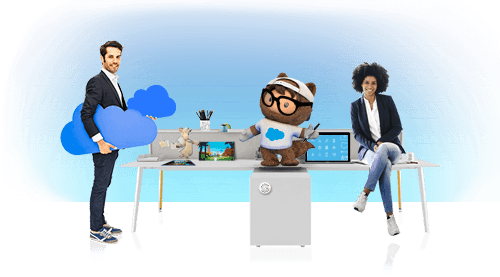When I first came to Salesforce four years ago, a lot of things made me very excited about the possibilities for design and design thinking. Earlier this year, I was challenged to create a more design-led culture and realize some of those possibilities.
To begin on this path, I wanted to answer this question for Salesforce: How do you inspire a design-led culture? Here are some observations.
1. In an increasingly digital world, people matter more
Digital transformation has changed the way the world operates, sometimes sacrificing personal connection for automation and efficiency. There has never been a more important time to ensure the customer is at the center of every conversation, whether it’s about privacy, trust, security, artificial intelligence (AI), or conversational user interface (UI). Customers have more choices than ever before. They’ll stick with brands they trust, who do right by them, and whose values they share. When creating new experiences, the customers’ presence must be felt. Knowing who you are as a brand and demonstrating that you care is paramount. Designing for the relationships you want will maintain the humanity of digital engagement.
2. Designing for people is a shared responsibility
The idea of the “democratization of design” can send shudders through the design community. It doesn’t mean that our craft, and the craftsmanship that comes with it, can be distributed across an organization to everyone. It does mean we recognize good ideas can come from anywhere, and we should empower anyone to take an active role in great experiences by creating tools, methods, and processes that allow a wider group to take part in design, rather than a specialized few. Ten people in a room problem solving for an hour will get much further than one person, alone, for 10 hours. Enabling those co-creative problem-solving sessions with tools, education, thought leadership, and methodology to get the most out of them is the future of our work.
3. The power of digital enables us to be personal at scale
In 1999, Salesforce arrived with a few radical propositions. We launched on a new alternative platform called “the cloud.” We invented a model called “software as a service.” We vowed to help companies succeed by making it easier than ever to win the hearts and minds of their customers. Today, we have more than 40,000 employees working across the globe to provide solutions for millions of subscribers. Yet walking our halls, we still feel authentic and familiar. We have a proven ability to innovate at scale, without sacrificing our culture. Everything about our mission, purpose, environment, values, and execution is intentional, which is the very essence of design culture, whether or not we use the word “design” to describe it.
4. Don’t seek perfection — seek to perfect
Building a lasting customer relationship starts with the recognition that relationships and people aren’t static, they’re dynamic. Designing for relationships must be seen as an evergreen effort in the service of an evolving set of customer needs. A successful approach employs both an organizational mindset (iterative and outcomes-oriented) and a set of tools (customer journey development, design thinking methods, and co-creation). This approach will align organizations around the ways in which we define and measure healthy relationships. At Salesforce, we call this “customer success” and measure it through Net Adoption Score, Net Promoter Score, renewals, ecosystem traffic, and user feedback. With a clear set of measures, and a mindset of continuing to perfect, behaviors naturally become user-centric. Design is never done.
5. End-to-end, values-driven design is a unique differentiator
We have hundreds of designers throughout the organization supporting countless touchpoints across the entire customer lifecycle, from presales to product design to post-purchase customer success. Instead of “shipping our org chart,” our teams come together through our passion for ensuring our brand and its values are expressed in every aspect of our relationships. These relationships span across the people we serve, the product we build, and the planet we live on. This is fairly unique in a world that often treats customer relationships as purely transactional.
The concepts in each of these considerations represent an amazing opportunity for our organization. And, when we start to look more broadly at the role relationship design can provide in inspiring, creating, and enabling business value, things become even more interesting.
With this in mind, Salesforce is launching an initiative to elevate and amplify the role that design plays in our organization. We’re working to maximize the effect our design teams’ contributions have in establishing and providing stronger relationships with our customers, and in turn, their customers.
Driving this initiative is Relationship Design, our commitment to build trust with every experience we co-create with our community. Grounded in our values, it’s how we shape lasting relationships.
We are establishing a program to share our learnings, our processes, and help engage everyone who influences the customer experience. That way, we can all take a different, more personal approach to serving the new needs of customers and exceeding evolving expectations.
Learn more about this initiative and stay updated as we expand our offerings. We look forward to sharing as we go.




























